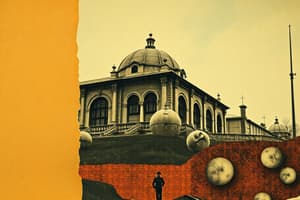Podcast
Questions and Answers
What is the Phi phenomenon?
What is the Phi phenomenon?
- A quirk of human perception that makes film possible (correct)
- A tool used to create the illusion of motion before photography
- A motion picture film camera invented by Thomas Edison and W.K.L. Dixon
- A type of camera invented by Joseph Nissefort NIEPS
What was the Kinetograph?
What was the Kinetograph?
- A type of camera invented by Joseph Nissefort NIEPS
- A motion picture film camera invented by Thomas Edison and W.K.L. Dixon (correct)
- A tool used to create the illusion of motion before photography
- A way of taking pictures on paper rather than metal or glass plates
What was the contribution of George Eastman to photography?
What was the contribution of George Eastman to photography?
- Inventing a way of taking pictures on paper rather than metal or glass plates (correct)
- Taking the first known camera photograph
- Inventing a tool used to create the illusion of motion before photography
- Inventing the Kinetograph
Film started as a collection of still images viewed in rapid succession to create the illusion of motion
Film started as a collection of still images viewed in rapid succession to create the illusion of motion
Persistence of vision is a quirk of human perception that makes film possible
Persistence of vision is a quirk of human perception that makes film possible
Filmmakers do not need to consider aesthetic choices when creating a film
Filmmakers do not need to consider aesthetic choices when creating a film
- The birth of photography as we know it was made possible by George Eastman's invention of a way of taking pictures on ______
- The birth of photography as we know it was made possible by George Eastman's invention of a way of taking pictures on ______
- Zoetropes and other pre-film animation tools were used to create the illusion of motion before ______.
- Zoetropes and other pre-film animation tools were used to create the illusion of motion before ______.
Who invented the world's first motion picture film camera?
Who invented the world's first motion picture film camera?
What is the significance of photography in the development of film?
What is the significance of photography in the development of film?
Flashcards are hidden until you start studying
Study Notes
The History of Film: From Magic Trick to Art Form
- Film is a universal language that allows us to tell stories and make sense of the world around us.
- Film sits at the intersection of art, industry, technology, and politics.
- Film started as a collection of still images viewed in rapid succession to create the illusion of motion.
- Persistence of vision and the Phi phenomenon are two quirks of human perception that make film possible.
- Zoetropes and other pre-film animation tools were used to create the illusion of motion before photography.
- Photography was a huge technological leap forward that allowed images to be captured and broken down like never before.
- The first known camera photograph was taken by a French inventor named Joseph Nissefort NIEPS.
- George Eastman invented a way of taking pictures on paper rather than metal or glass plates, which led to the birth of photography as we know it.
- Motion studies were conducted by photographers and inventors all over the world to break down continuous motion into individual images.
- Thomas Edison and W.K.L. Dixon invented the Kinetograph, the world's first motion picture film camera.
- Filmmakers carefully craft aesthetic choices to show a specific point of view and affect how the audience interprets reality.
- Film was stumbled upon through a series of happy accidents and innovations, leading to a world of film to discover and learn from.
The History of Film: From Magic Trick to Art Form
- Film is a universal language that allows us to tell stories and make sense of the world around us.
- Film sits at the intersection of art, industry, technology, and politics.
- Film started as a collection of still images viewed in rapid succession to create the illusion of motion.
- Persistence of vision and the Phi phenomenon are two quirks of human perception that make film possible.
- Zoetropes and other pre-film animation tools were used to create the illusion of motion before photography.
- Photography was a huge technological leap forward that allowed images to be captured and broken down like never before.
- The first known camera photograph was taken by a French inventor named Joseph Nissefort NIEPS.
- George Eastman invented a way of taking pictures on paper rather than metal or glass plates, which led to the birth of photography as we know it.
- Motion studies were conducted by photographers and inventors all over the world to break down continuous motion into individual images.
- Thomas Edison and W.K.L. Dixon invented the Kinetograph, the world's first motion picture film camera.
- Filmmakers carefully craft aesthetic choices to show a specific point of view and affect how the audience interprets reality.
- Film was stumbled upon through a series of happy accidents and innovations, leading to a world of film to discover and learn from.
The History of Film: From Magic Trick to Art Form
- Film is a universal language that allows us to tell stories and make sense of the world around us.
- Film sits at the intersection of art, industry, technology, and politics.
- Film started as a collection of still images viewed in rapid succession to create the illusion of motion.
- Persistence of vision and the Phi phenomenon are two quirks of human perception that make film possible.
- Zoetropes and other pre-film animation tools were used to create the illusion of motion before photography.
- Photography was a huge technological leap forward that allowed images to be captured and broken down like never before.
- The first known camera photograph was taken by a French inventor named Joseph Nissefort NIEPS.
- George Eastman invented a way of taking pictures on paper rather than metal or glass plates, which led to the birth of photography as we know it.
- Motion studies were conducted by photographers and inventors all over the world to break down continuous motion into individual images.
- Thomas Edison and W.K.L. Dixon invented the Kinetograph, the world's first motion picture film camera.
- Filmmakers carefully craft aesthetic choices to show a specific point of view and affect how the audience interprets reality.
- Film was stumbled upon through a series of happy accidents and innovations, leading to a world of film to discover and learn from.
The History of Film: From Magic Trick to Art Form
- Film is a universal language that allows us to tell stories and make sense of the world around us.
- Film sits at the intersection of art, industry, technology, and politics.
- Film started as a collection of still images viewed in rapid succession to create the illusion of motion.
- Persistence of vision and the Phi phenomenon are two quirks of human perception that make film possible.
- Zoetropes and other pre-film animation tools were used to create the illusion of motion before photography.
- Photography was a huge technological leap forward that allowed images to be captured and broken down like never before.
- The first known camera photograph was taken by a French inventor named Joseph Nissefort NIEPS.
- George Eastman invented a way of taking pictures on paper rather than metal or glass plates, which led to the birth of photography as we know it.
- Motion studies were conducted by photographers and inventors all over the world to break down continuous motion into individual images.
- Thomas Edison and W.K.L. Dixon invented the Kinetograph, the world's first motion picture film camera.
- Filmmakers carefully craft aesthetic choices to show a specific point of view and affect how the audience interprets reality.
- Film was stumbled upon through a series of happy accidents and innovations, leading to a world of film to discover and learn from.
Studying That Suits You
Use AI to generate personalized quizzes and flashcards to suit your learning preferences.



